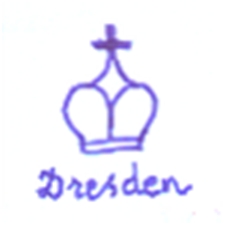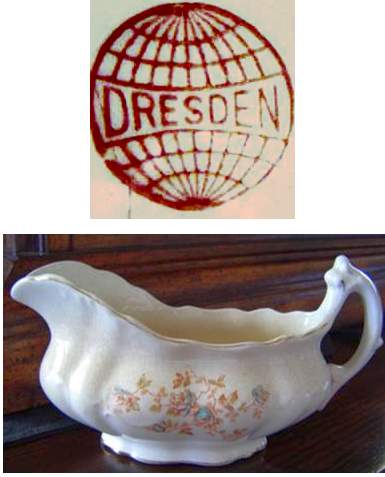Dresden Porcelain - Pottery Mark Query
by Gretchan
(California, USA)
Dresden Porcelain - Pottery Mark Query:- I was given a complete set (12) of Dresden china. The marking at the bottom of each piece says Dresden made in Saxony #802. It has a gold rose on the bottom of each piece also. Its is beautiful with with birds and a lot of gold. I have compotes, demitasse cups/saucers as well as 12 complete place settings. I was wondering if you could tell me anything about them or how I might find out their worth.
Thank you very much
Gretchan
=======================================
Reply from Peter (admin) below - just scroll down
 |
Reply by Peter (admin)
To:- Dresden Porcelain - Pottery Mark Query
Hi Gretchan
Thank you for your query on your Dresden Porcelain.
In 1883, this famous blue crown Dresden porcelain mark was registered as a liason between the four most prominent ceramic decorators in the city - Karl Richard Klemm, founded 1869, RWZR register no. 24; Donath & Co, founded 1872, RWZR register no. 25; Oswald Lorenz, (commission agent), RWZR register no. 26; Adolf Hamman, founded 1866, RWZR register no. 27.
So it is not the mark of one individual factory, but an early example of a 'marketing' brand dreamt up by a small group of expert ceramic decorators. They did not sculpt or make the porcelain, they just bought in white ware and painted it.
When other people, not part of their registry, tried to use this mark, they came down on them like a ton of bricks.
Therefore, with eventually over 200 small decorators in the city of Dresden at that time, each with a slightly different mark, it became impossible to catalogue all the individual marks. So today, especially in the wake of the destruction of Dresden in WW2, often there can't ever be a name put to a Dresden pottery mark, sadly.
However, with yours, there are names and those names are:
Karl Richard Klemm
Donath & Co
Oswald Lorenz
Adolf Hamman
I think you are a very lucky collector indeed!
"Dresden porcelain" is generally a misnomer when applied to a 'maker' or the individual pottery mark of a factory. It is more a description of an artistic movement like 'Art Deco' or 'Art Nouveau'. Meissen, however, is a specific factory with a specific history and set of pottery marks.
Dresden, being the capital of Saxony, was home to several ceramic decorating studios which arose in the 19th century. Romanticism was a burgeoning trend and Dresden, as an important cultural center, was right at the heart of this porcelain romance.
The "Dresden style" was born.
Much emulated, the "Dresden style" influenced a host of imitators, many of them happily calling their wares 'Dresden' or 'in the Dresden style'. Between 1855 and 1944 there were over 200 recorded decorating shops in Dresden. This does not take into account any outside Dresden. So you can see the Dresden collecting field is one for experts or people with access to expert advice (see my link below).
The pottery mark on various wares may state Dresden, Dresden Art, Dresdener Art or Dresdner Art (even if the items are made elsewhere). Essentially, these makers all wanted to profit from the well-known designs.
However, experts maintain that the some of the imitators achieved an artistry to match the original decorators (eg. Alka-Kunst, Alboth & Kaiser, Ernst Bohne & Sons, Irish Dresden, and Sitzendorf).
So what is the difference between Dresden and Meissen?
Essentially, Dreseden was the location where Böttger discovered the secret of Chinese hard-paste porcelain (see my Meissen listing for the full story). When production began in earnest, the manufacturing plant was actually located in the town of Meissen about 15 miles away. Most of the Meissen wares were presented and sold in Dresden city, thus enabling the melding of the two names in peoples' minds.
Collectors can distinguish the wares of Meissen from the Dresden decorators by the simple rule of thumb that the Dresden decorators pottery marks generally have the blue crown stamp or related porcelain mark while Meissen, of course, has its own distinctive set of marks.
The fanciful style Dresden style is also referred to as the 'Vienna' style.
Other later decorators who also employed the Crown and Dresden mark were names such as Ambrosius Lamm, Carl Thieme, Helena Wolfsohn and Franziska Hirsch.
The famous "Dresden lace," was made by dipping real lace into porcelain slip and then firing.
Sadly, much of the work and history of Dresden was destroyed during WWII.
Hopefully that answers some of your question about the history of your set! Regarding finding out what they are worth, the first thing to say is valuations for vintage and fine china are specialist niches unto themselves with vast amounts of knowledge and research material required. The following page is a 'must see' if you are researching fine china - for value and identification:-
Researching the identity and value of antique and vintage fine china.
Best regards,
Peter (admin)
p.s. Please post comments below which you think might be helpful……
Comments for Dresden Porcelain - Pottery Mark Query
|
||
|
||
|
||
|
||
|
||
|
||
|
||
|
||
|
||
|
||
|
||
|
||
|
||
|
||
|
||
|
||
|
||
|
||
|
||
|
||
|
||
|
||
|
||
|
||

Inherited a china set?... Download my free 7-point checklist to instantly assess its potential value.
From the Studio
• Peter Holland Posters
• Sculpture Studio


